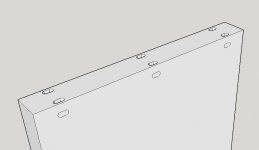Svar said:
No. Not without glue. Put together a piece of furniture with loose tenons without glue and see how it holds up to racking.
Not necessarily, we're not assembling furniture with just loose tenons...we're using loose tenons while being held tightly together with the joint clamping force of multiple D14 metal Dominos. No one has spoken up at this point to say whether this approach is realistic or folly. I assume the reason it was considered is because it's any easy fix...if it's a truly viable one.
Moreover, this brings up a more interesting situation that if this a commissioned product for a customer, then the conversation needs to be extended further and I think the solution could change drastically.
I assumed this was a home brew table for the family, so then it's in an environment that's friendly and any table/leg movement can be monitored on a continual daily basis. If the joint becomes wobbly or weak, it will be noticed in real time and the proper adjustments can be made by the original creator.
However, if this is a commissioned product, then once you unload/deliver/setup the table, any subtle movement over the next weeks/months will probably not be noticed by the owner until the movement becomes so great that it collapses or almost collapses on the floor.
And you certainly don't want to advise the client to be on the look out for any leg movement. That doesn't inspire any confidence in the client and probably eliminates any further commissions from him/her.
So if a full size test model of this table is not in the cards, and stretchers are also not in the cards, I'd then be a fan of inserting steel structural elements in the table & the legs to solve these issues...then again I'm a huge fan of metals. Metals are good...sometimes, even better than wood. [smile]

